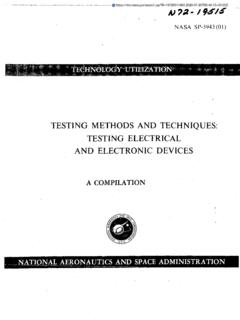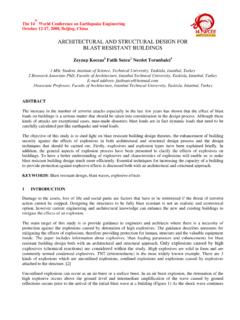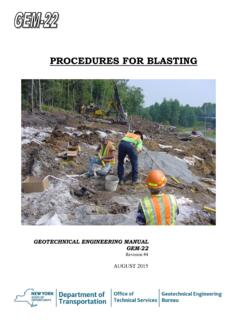Transcription of Asteroid Generated Tsunami: Summary of NASA/NOAA …
1 NASA/Technical Memorandum (NASA/TM-219463) 2017. Asteroid Generated Tsunami: Summary of NASA/NOAA Workshop David Morrison Ames Research Center, Moffett Field, California Ethiraj Venkatapathy Ames Research Center, Moffett Field, California JANUARY 2017. Abstract A two-day workshop on tsunami Generated by Asteroid impacts in the ocean resulted in a broad consensus that the Asteroid impact tsunami threat is not as great as previously thought, that airburst events in particular are unlikely to produce significant damage by tsunami, and that the tsunami contribution to the global ensemble impact hazard is substantially less than the contribution from land impacts.
2 Workshop Organization The 2016 Asteroid Generated Tsunami (AGT) Workshop was co-sponsored by the NASA Ames Asteroid Threat Assessment Project (ATAP) and the NOAA Pacific Marine Environmental Lab (PMEL). The two-day workshop, held on August 23-24 at the PMEL facility in Seattle, WA was attended by a multidisciplinary team of experts from NASA (Ames, JPL), NOAA, the DoE Tri- Labs (LLNL, SNL and LANL), DHS, FEMA, and academia to address the hazard of tsunami created by Asteroid impacts. Program managers in attendance were Lindley Johnson, NASA. Planetary Defense Coordination Office Executive, and Michael Angrove, NOAA Tsunami Program Manager.
3 The workshop, led by Ethiraj Venkatapathy and David Morrison of NASA Ames, was organized into three sessions: 1) Near-field wave generation by the impact; 2) Long distance wave propagation; 3) Damage from coastal run-up and inundation, and associated hazard. Workshop approaches were to compare simulations to understand differences in the results and gain confidence in the modeling for both formation and propagation of tsunami from Asteroid impacts, and to use this information for preliminary global risk assessment. The workshop focus was on smaller asteroids (diameter less than 250m), which represent the most frequent impacts.
4 Near-field Wave Generation by the Impact The charge to Session 1 was to model the tsunami-producing potential of airbursts and direct water impacts, and to evaluate the nature of the waves produced. The approach was to model specific airburst cases (energy 5MT, 100MT, and 250MT, corresponding to approximate diameters for stony asteroids of 50m, 125m, and 180m) and also cratering impacts in shallow and deep water. The session organizer was Mark Boslough (Sandia National Labs), and the discussion panel chair was Bob Weaver (Los Alamos National Lab). The speakers were Boslough, Galen Gisler (Los Alamos National Lab), Michael Aftosmis (NASA Ames), and Darrel Robertson (NASA Ames).
5 The results presented reflect a major improvement in computing capability and code complexity over the models used for the 2003 NASA SDT analysis. Simulations were compared using a variety of both 2D and 3D codes (xRAGE, CTH, ALE3D, and Cart3D). The most sophisticated hyrocodes required supercomputer runs of weeks to months. The Cart3D code was used to evaluate the effects of atmosphere energy deposition based on the NASA fragment-cloud model and angle-of-attack effect that result in non-circular surface damage footprints. The speakers agreed that for both airbursts over water and water impacts with energies of 5MT, 100MT, and 250MT, the resulting waves would not travel long distances.
6 For a given energy, airbursts were less effective in generating waves, but in both cases, the waves formed are essentially circular (unlike a typical seismically Generated tsunami) and dissipate rapidly due to the localized nature of the source and the turbulence of the wave. Local damage from impacts into the water may be 2. similar to the cases of landslides into fjords, but these disturbances do not travel far. The potential for severe damage from Asteroid Generated tsunami over the energy range studied is therefore limited to impacts near the shore, and even in these cases the air blast , fireball, and possible ejection of sediment in shallow water areas may exceed the damage from the wave.
7 The airbursts modeled, most of which assumed an explosion altitude of 10 km, produced a wave from blast over-pressure. Most of the models did not explicitly consider other explosion altitudes or combined effects of airburst and solid impact on the water. Also not modeled were possible coupling mechanisms that might contribute to wave formation, such as steam explosions, plume ejection and collapse. It is not expected that these effects will substantially change the conclusions, but they deserve further consideration. While there may be conditions under which dangerous waves can be Generated ( airburst over very deep water or impact very near shore), the probability of such events is relatively small and therefore they do not significantly contribute to the ensemble hazard.
8 There was a solid consensus among the workshop attendees that impact far from shore of asteroids <250m do not endanger coastal populations and infrastructure, and that the 2003 SDT Report ( ) substantially overestimated the hazard from ocean impacts. Propagation of Waves from Asteroid Impacts The charge to Session 2 was to determine the ability of near-field impact-produced waves (from Session 1) to propagate over large distances, in deep and shallow water. Since propagation depends on several variables, including size of tsunami, distance of travel, and specific bathymetry along the path, multiple examples are needed to allow some generalizations.
9 The session organizer was Marsha Berger (New York University), and the discussion panel chair was Robert Weiss (Virginia Polytechnic Institute and State University). The speakers were Berger, Souheil Ezzedine (Lawrence Livermore National Lab), and Vasily Titov (Pacific Marine Environmental Lab/NOAA). Robert Weiss also contributed some model computations. The sites chosen for comparison were the South China Sea, the city of Westport WA, and the Long Beach area in southern California. The major uncertainty in the presentations in Session 2 concerned the applicability of different computer codes to the propagation of waves described by Session 1.
10 Berger used a computationally efficient code called GeoClaw that solves the Nonlinear Shallow Water Equations, which gives somewhat different results from the more complex Boussinesq codes. Ezzedine and Weiss used different Boussinesq codes. Titov discussed shallow water codes and also results from the NOAA models for predicting the effects of seismically Generated tsunami, but he did not present results for the shorter-wavelength waves from impacts. Due to differences in implementation, fidelity and boundary conditions, detailed code comparisons were not possible. Although there were differences in the models, the consensus was that the waves that reached the shore as a result of airburst cases were not significantly different from one another.















